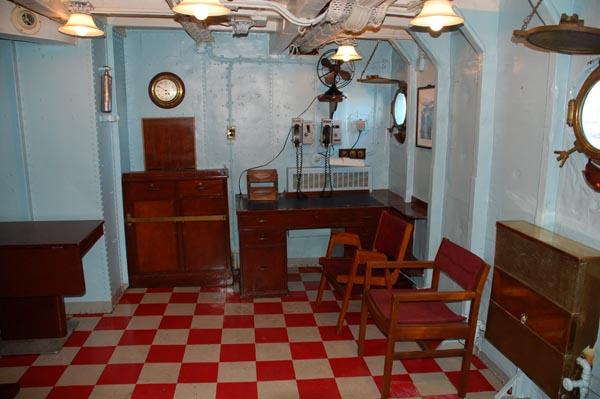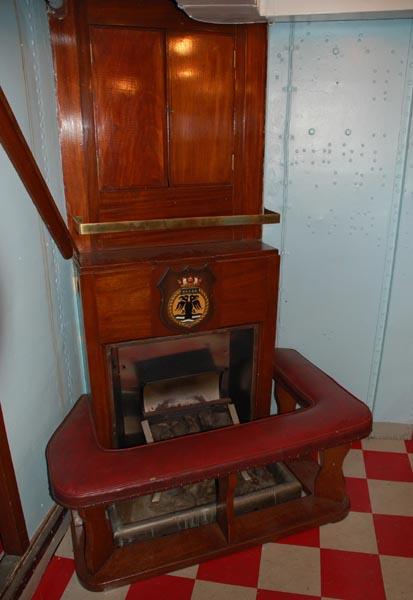It was here that the Captain managed the affairs of the ship. This space consists of the office or Day Cabin, a bedroom and a washroom (head). Generally speaking, the Captain used this cabin while in harbour. At sea, he lived in the Captain's Sea Cabin in order to be close to the Bridge and Operations Room. All of the furnishings in the Captain's Day Cabin are original.
 |
| Starboard side view looking forward. The deck in this compartment has been restored to its original Korean war era colour scheme using 9"x 9" linoleum tiles. The bulkheads have also been restored to an authentic colour for that era. (Photo by Jerry Proc) |
 |
| Starboard /aft view. The Captain's bed and washroom are beyond the right side of the photo. Note the solid brass heater cover below the scuttle. (Photo by Jerry Proc) |
The late Cdr. Bob Willson (RCN, Ret'd) provides details about which cabin the Captain used when the HAIDA was at sea."The most relevant answer is, "It all depends". I think in wartime (WWII and Korea) he definitely slept in his Sea Cabin when the ship was at sea. He also used it to relax if the situation was such that he wanted/needed to be close to the Bridge or Ops Room. He took his meals wherever he was. If he needed to go to his Day Cabin for a bath, etc. he would call the XO to take over temporarily.
In peacetime, it depended on the situation. If the ship was involved with exercises to simulate wartime conditions, the CO did the same as in wartime. If it was an ocean passage without much going on he would probably eat and sleep in his Day Cabin but spend several hours a day on the bridge training inexperienced officers and generally keeping an eye on things. If the ship was close to land he might sleep in the Sea Cabin.
Each CO had "Standing Orders" that detailed specific situations as to when he should be called, and every night he wrote up his "Night Order Book" to cover any situation that he though might come up during the night (e.g. making a landfall or a rendezvous with other ships, etc).
The OOW (Officer of the Watch) was in charge on the bridge, even if the CO was there, unless the CO said that he was taking over. That is what the OOW was trained for, and had a certificate to prove it. Officers without a Watchkeeping Certificate were always supervised and trained by a qualified OOW. If the CO felt a particular officer was qualified but lacking in experience, he might spend more time on the bridge and sleep in the Sea Cabin, otherwise he left the OOW alone to do the job he was supposed to do".
The Captain's Day Cabin also served as an emergency operating room. It was an ideal arrangement as it was close to Sick Bay. There were two known cases where this cabin was used for surgery. On the starboard bulkhead of this cabin a two square inch metal patch can be seen. This covers a bullet hole from an Oerlikon round fired by the German destroyer T-29 on April 26, 1944. Rumor has it that the round which entered the cabin destroyed the heads on Cdr. Harry DeWolf's golf clubs but this has been neither confirmed or denied.
 |
| Port side aft view of the Captain's Day Cabin. This is a settee with a built-in electric fire place. It was the best place on the ship if one needed to have their backsides warmed up. (Photo by Jerry Proc) |
 |
| Captain's Day Cabin bunk.(Photo by Jerry Proc) |
 |
| Even though the Officers Heads were right across the passageway, the Captain was afforded his own private toilet and bathtub. (Photo by Jerry Proc) |